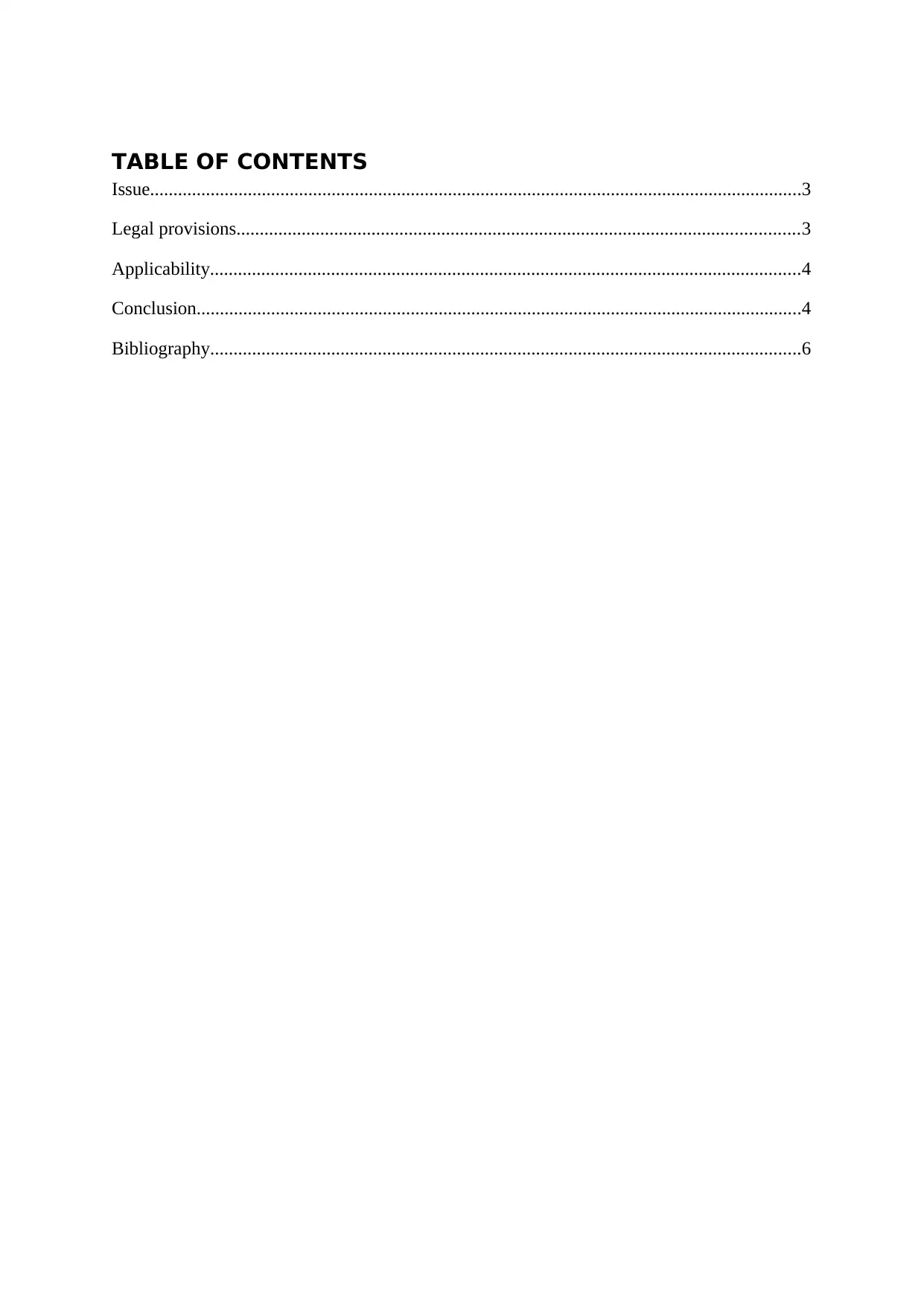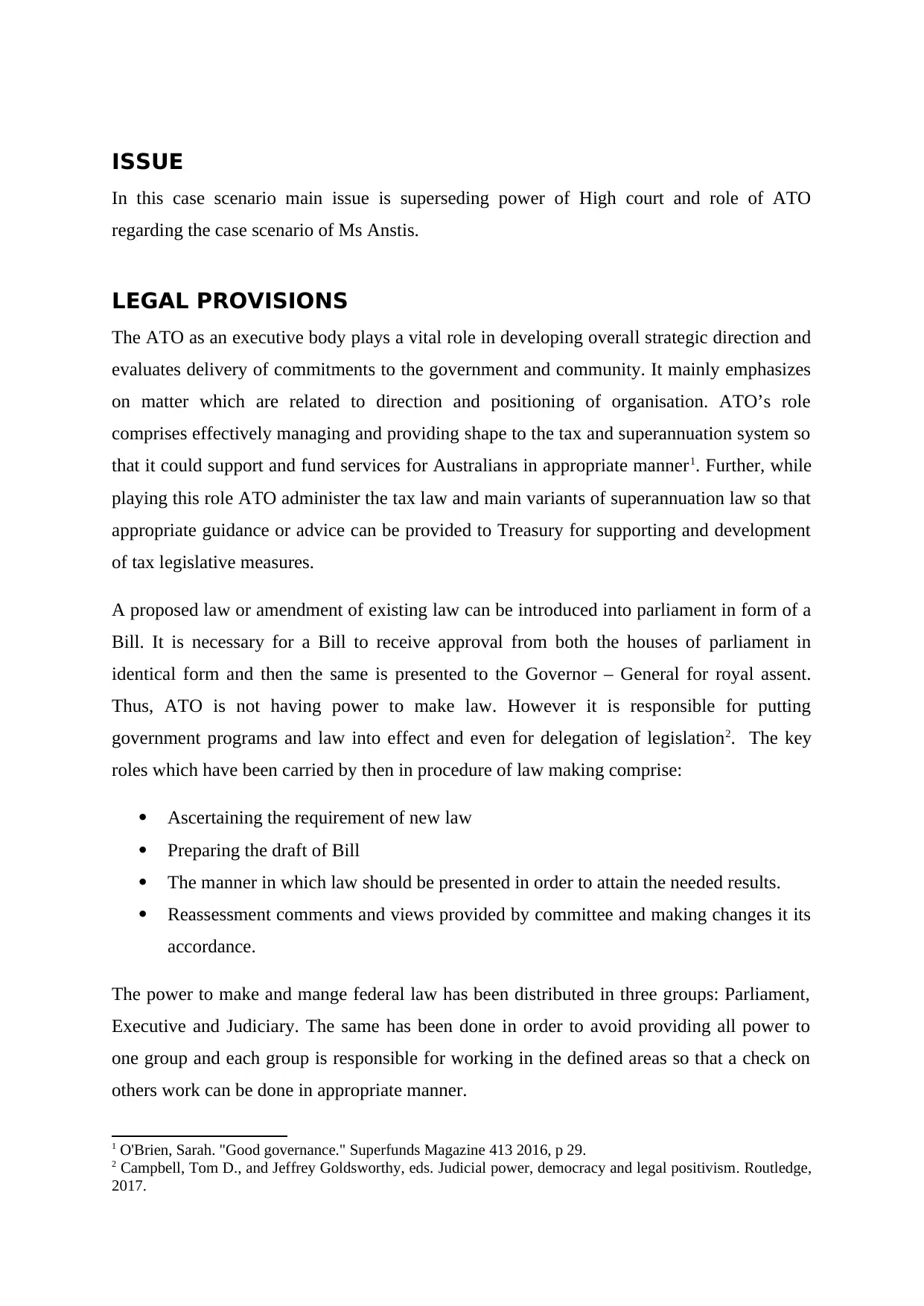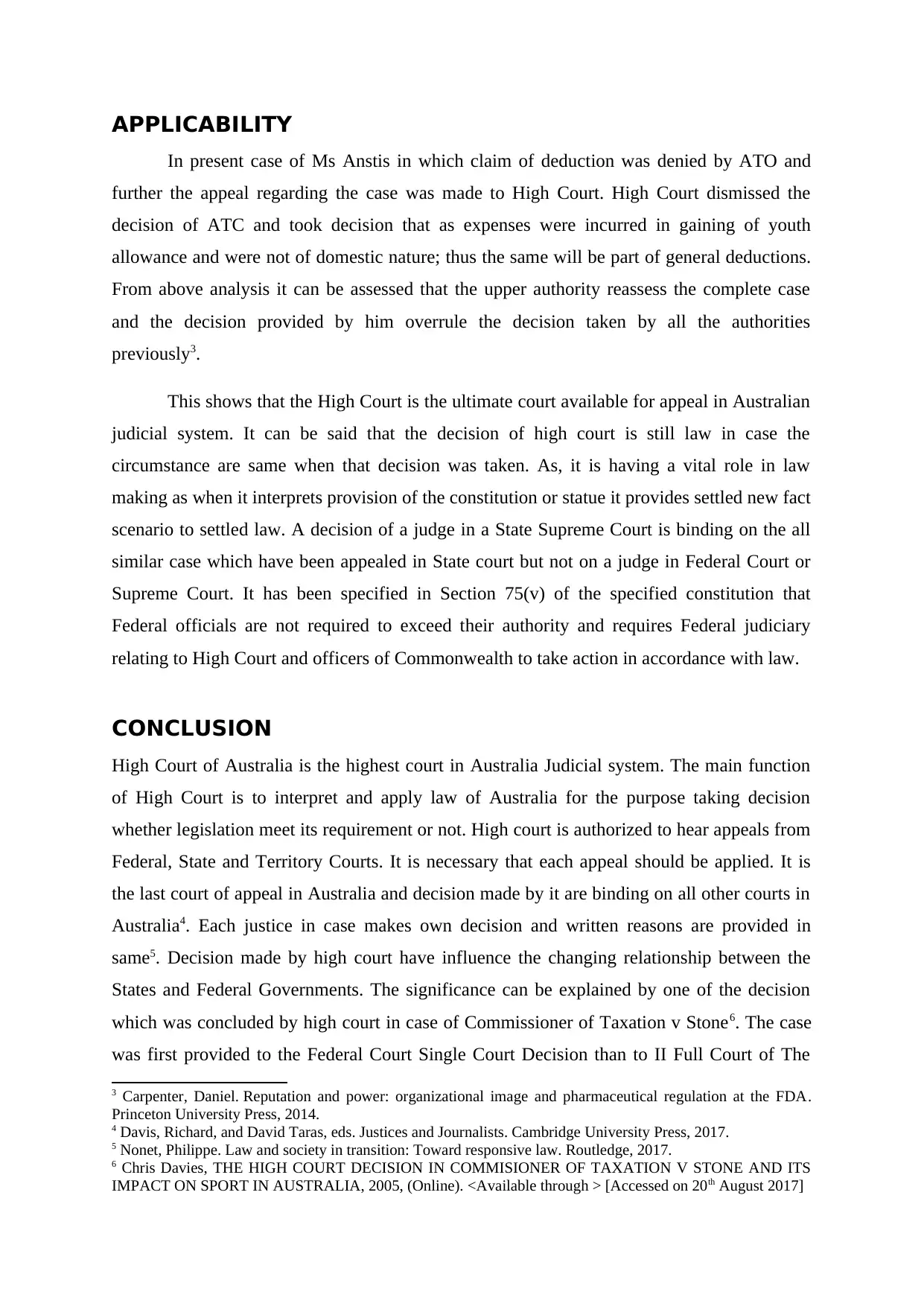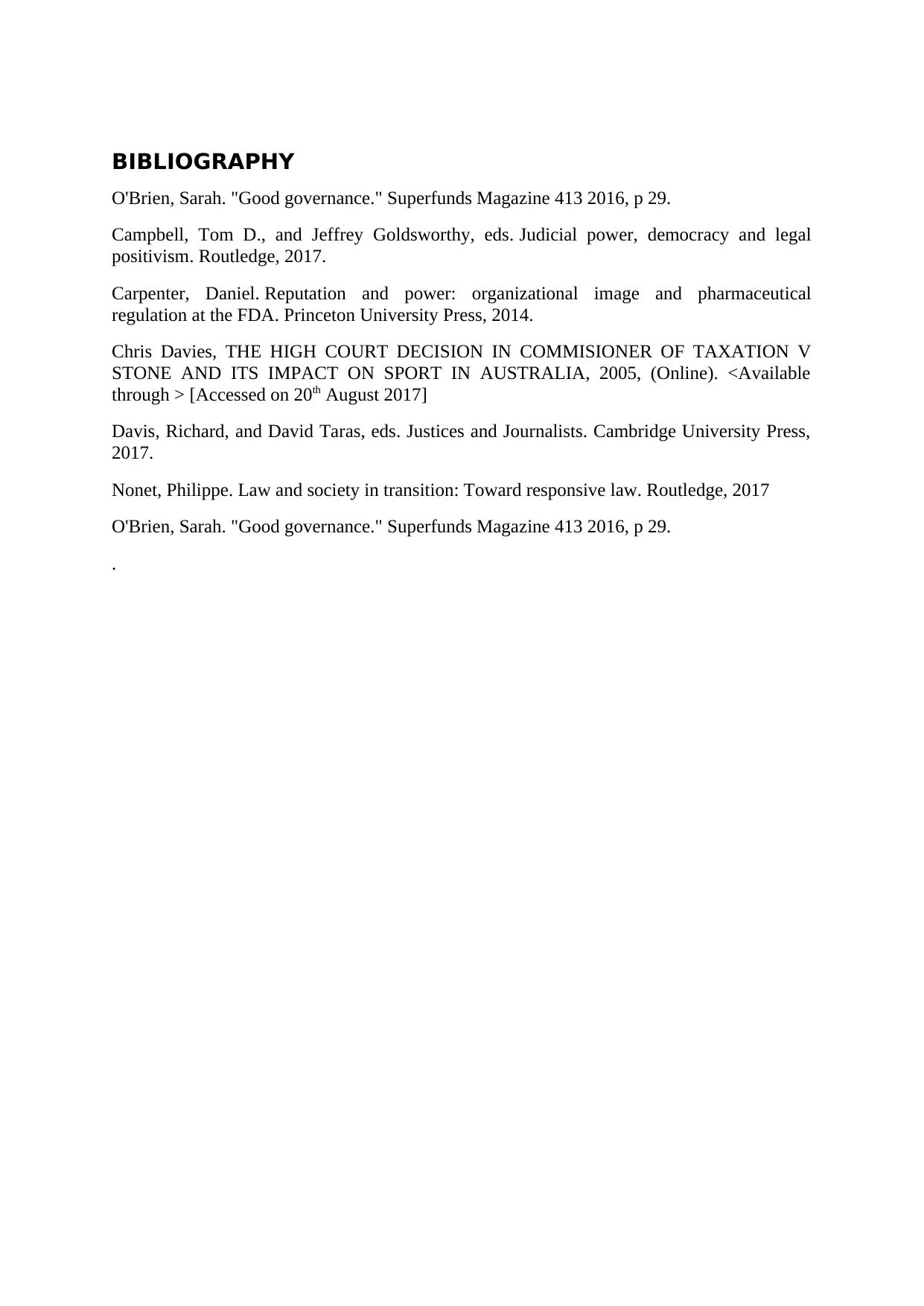Law Report: Australian High Court's Role and Legal Framework
VerifiedAdded on 2020/03/02
|7
|983
|92
Report
AI Summary
This report examines the legal relationship between the Australian Taxation Office (ATO) and the High Court of Australia, focusing on the power of judicial review and the interpretation of tax law. The report begins by outlining the roles and responsibilities of the ATO in administering tax and superannuation laws, emphasizing its executive function in implementing government programs and legislation. It then delves into the legal provisions that define the ATO's authority and the limitations imposed by the judicial branch, particularly the High Court. The analysis includes a discussion of the separation of powers within the Australian legal system, highlighting the High Court's role as the ultimate court of appeal and its binding decisions on all other courts. The report uses the case of Commissioner of Taxation v Stone as an example of the High Court's influence and concludes by emphasizing the importance of the High Court's decisions in shaping the relationship between federal and state governments and in clarifying legal interpretations. The provided bibliography offers a selection of resources used in the analysis of the report.

ASSIGNMENT
Paraphrase This Document
Need a fresh take? Get an instant paraphrase of this document with our AI Paraphraser

TABLE OF CONTENTS
Issue............................................................................................................................................3
Legal provisions.........................................................................................................................3
Applicability...............................................................................................................................4
Conclusion..................................................................................................................................4
Bibliography...............................................................................................................................6
Issue............................................................................................................................................3
Legal provisions.........................................................................................................................3
Applicability...............................................................................................................................4
Conclusion..................................................................................................................................4
Bibliography...............................................................................................................................6

ISSUE
In this case scenario main issue is superseding power of High court and role of ATO
regarding the case scenario of Ms Anstis.
LEGAL PROVISIONS
The ATO as an executive body plays a vital role in developing overall strategic direction and
evaluates delivery of commitments to the government and community. It mainly emphasizes
on matter which are related to direction and positioning of organisation. ATO’s role
comprises effectively managing and providing shape to the tax and superannuation system so
that it could support and fund services for Australians in appropriate manner1. Further, while
playing this role ATO administer the tax law and main variants of superannuation law so that
appropriate guidance or advice can be provided to Treasury for supporting and development
of tax legislative measures.
A proposed law or amendment of existing law can be introduced into parliament in form of a
Bill. It is necessary for a Bill to receive approval from both the houses of parliament in
identical form and then the same is presented to the Governor – General for royal assent.
Thus, ATO is not having power to make law. However it is responsible for putting
government programs and law into effect and even for delegation of legislation2. The key
roles which have been carried by then in procedure of law making comprise:
Ascertaining the requirement of new law
Preparing the draft of Bill
The manner in which law should be presented in order to attain the needed results.
Reassessment comments and views provided by committee and making changes it its
accordance.
The power to make and mange federal law has been distributed in three groups: Parliament,
Executive and Judiciary. The same has been done in order to avoid providing all power to
one group and each group is responsible for working in the defined areas so that a check on
others work can be done in appropriate manner.
1 O'Brien, Sarah. "Good governance." Superfunds Magazine 413 2016, p 29.
2 Campbell, Tom D., and Jeffrey Goldsworthy, eds. Judicial power, democracy and legal positivism. Routledge,
2017.
In this case scenario main issue is superseding power of High court and role of ATO
regarding the case scenario of Ms Anstis.
LEGAL PROVISIONS
The ATO as an executive body plays a vital role in developing overall strategic direction and
evaluates delivery of commitments to the government and community. It mainly emphasizes
on matter which are related to direction and positioning of organisation. ATO’s role
comprises effectively managing and providing shape to the tax and superannuation system so
that it could support and fund services for Australians in appropriate manner1. Further, while
playing this role ATO administer the tax law and main variants of superannuation law so that
appropriate guidance or advice can be provided to Treasury for supporting and development
of tax legislative measures.
A proposed law or amendment of existing law can be introduced into parliament in form of a
Bill. It is necessary for a Bill to receive approval from both the houses of parliament in
identical form and then the same is presented to the Governor – General for royal assent.
Thus, ATO is not having power to make law. However it is responsible for putting
government programs and law into effect and even for delegation of legislation2. The key
roles which have been carried by then in procedure of law making comprise:
Ascertaining the requirement of new law
Preparing the draft of Bill
The manner in which law should be presented in order to attain the needed results.
Reassessment comments and views provided by committee and making changes it its
accordance.
The power to make and mange federal law has been distributed in three groups: Parliament,
Executive and Judiciary. The same has been done in order to avoid providing all power to
one group and each group is responsible for working in the defined areas so that a check on
others work can be done in appropriate manner.
1 O'Brien, Sarah. "Good governance." Superfunds Magazine 413 2016, p 29.
2 Campbell, Tom D., and Jeffrey Goldsworthy, eds. Judicial power, democracy and legal positivism. Routledge,
2017.
⊘ This is a preview!⊘
Do you want full access?
Subscribe today to unlock all pages.

Trusted by 1+ million students worldwide

APPLICABILITY
In present case of Ms Anstis in which claim of deduction was denied by ATO and
further the appeal regarding the case was made to High Court. High Court dismissed the
decision of ATC and took decision that as expenses were incurred in gaining of youth
allowance and were not of domestic nature; thus the same will be part of general deductions.
From above analysis it can be assessed that the upper authority reassess the complete case
and the decision provided by him overrule the decision taken by all the authorities
previously3.
This shows that the High Court is the ultimate court available for appeal in Australian
judicial system. It can be said that the decision of high court is still law in case the
circumstance are same when that decision was taken. As, it is having a vital role in law
making as when it interprets provision of the constitution or statue it provides settled new fact
scenario to settled law. A decision of a judge in a State Supreme Court is binding on the all
similar case which have been appealed in State court but not on a judge in Federal Court or
Supreme Court. It has been specified in Section 75(v) of the specified constitution that
Federal officials are not required to exceed their authority and requires Federal judiciary
relating to High Court and officers of Commonwealth to take action in accordance with law.
CONCLUSION
High Court of Australia is the highest court in Australia Judicial system. The main function
of High Court is to interpret and apply law of Australia for the purpose taking decision
whether legislation meet its requirement or not. High court is authorized to hear appeals from
Federal, State and Territory Courts. It is necessary that each appeal should be applied. It is
the last court of appeal in Australia and decision made by it are binding on all other courts in
Australia4. Each justice in case makes own decision and written reasons are provided in
same5. Decision made by high court have influence the changing relationship between the
States and Federal Governments. The significance can be explained by one of the decision
which was concluded by high court in case of Commissioner of Taxation v Stone6. The case
was first provided to the Federal Court Single Court Decision than to II Full Court of The
3 Carpenter, Daniel. Reputation and power: organizational image and pharmaceutical regulation at the FDA.
Princeton University Press, 2014.
4 Davis, Richard, and David Taras, eds. Justices and Journalists. Cambridge University Press, 2017.
5 Nonet, Philippe. Law and society in transition: Toward responsive law. Routledge, 2017.
6 Chris Davies, THE HIGH COURT DECISION IN COMMISIONER OF TAXATION V STONE AND ITS
IMPACT ON SPORT IN AUSTRALIA, 2005, (Online). <Available through > [Accessed on 20th August 2017]
In present case of Ms Anstis in which claim of deduction was denied by ATO and
further the appeal regarding the case was made to High Court. High Court dismissed the
decision of ATC and took decision that as expenses were incurred in gaining of youth
allowance and were not of domestic nature; thus the same will be part of general deductions.
From above analysis it can be assessed that the upper authority reassess the complete case
and the decision provided by him overrule the decision taken by all the authorities
previously3.
This shows that the High Court is the ultimate court available for appeal in Australian
judicial system. It can be said that the decision of high court is still law in case the
circumstance are same when that decision was taken. As, it is having a vital role in law
making as when it interprets provision of the constitution or statue it provides settled new fact
scenario to settled law. A decision of a judge in a State Supreme Court is binding on the all
similar case which have been appealed in State court but not on a judge in Federal Court or
Supreme Court. It has been specified in Section 75(v) of the specified constitution that
Federal officials are not required to exceed their authority and requires Federal judiciary
relating to High Court and officers of Commonwealth to take action in accordance with law.
CONCLUSION
High Court of Australia is the highest court in Australia Judicial system. The main function
of High Court is to interpret and apply law of Australia for the purpose taking decision
whether legislation meet its requirement or not. High court is authorized to hear appeals from
Federal, State and Territory Courts. It is necessary that each appeal should be applied. It is
the last court of appeal in Australia and decision made by it are binding on all other courts in
Australia4. Each justice in case makes own decision and written reasons are provided in
same5. Decision made by high court have influence the changing relationship between the
States and Federal Governments. The significance can be explained by one of the decision
which was concluded by high court in case of Commissioner of Taxation v Stone6. The case
was first provided to the Federal Court Single Court Decision than to II Full Court of The
3 Carpenter, Daniel. Reputation and power: organizational image and pharmaceutical regulation at the FDA.
Princeton University Press, 2014.
4 Davis, Richard, and David Taras, eds. Justices and Journalists. Cambridge University Press, 2017.
5 Nonet, Philippe. Law and society in transition: Toward responsive law. Routledge, 2017.
6 Chris Davies, THE HIGH COURT DECISION IN COMMISIONER OF TAXATION V STONE AND ITS
IMPACT ON SPORT IN AUSTRALIA, 2005, (Online). <Available through > [Accessed on 20th August 2017]
Paraphrase This Document
Need a fresh take? Get an instant paraphrase of this document with our AI Paraphraser

Federal Court Decision and finally to High court as the appellate was not satisfied with the
decision taken by previous court. High court took an unanimous decision in this case and
clarified the activities in relation to athletes with constituted as carrying on business and
further represented as taxable income and the same was accepted by both the parties.
decision taken by previous court. High court took an unanimous decision in this case and
clarified the activities in relation to athletes with constituted as carrying on business and
further represented as taxable income and the same was accepted by both the parties.

BIBLIOGRAPHY
O'Brien, Sarah. "Good governance." Superfunds Magazine 413 2016, p 29.
Campbell, Tom D., and Jeffrey Goldsworthy, eds. Judicial power, democracy and legal
positivism. Routledge, 2017.
Carpenter, Daniel. Reputation and power: organizational image and pharmaceutical
regulation at the FDA. Princeton University Press, 2014.
Chris Davies, THE HIGH COURT DECISION IN COMMISIONER OF TAXATION V
STONE AND ITS IMPACT ON SPORT IN AUSTRALIA, 2005, (Online). <Available
through > [Accessed on 20th August 2017]
Davis, Richard, and David Taras, eds. Justices and Journalists. Cambridge University Press,
2017.
Nonet, Philippe. Law and society in transition: Toward responsive law. Routledge, 2017
O'Brien, Sarah. "Good governance." Superfunds Magazine 413 2016, p 29.
.
O'Brien, Sarah. "Good governance." Superfunds Magazine 413 2016, p 29.
Campbell, Tom D., and Jeffrey Goldsworthy, eds. Judicial power, democracy and legal
positivism. Routledge, 2017.
Carpenter, Daniel. Reputation and power: organizational image and pharmaceutical
regulation at the FDA. Princeton University Press, 2014.
Chris Davies, THE HIGH COURT DECISION IN COMMISIONER OF TAXATION V
STONE AND ITS IMPACT ON SPORT IN AUSTRALIA, 2005, (Online). <Available
through > [Accessed on 20th August 2017]
Davis, Richard, and David Taras, eds. Justices and Journalists. Cambridge University Press,
2017.
Nonet, Philippe. Law and society in transition: Toward responsive law. Routledge, 2017
O'Brien, Sarah. "Good governance." Superfunds Magazine 413 2016, p 29.
.
⊘ This is a preview!⊘
Do you want full access?
Subscribe today to unlock all pages.

Trusted by 1+ million students worldwide

1 out of 7
Related Documents
Your All-in-One AI-Powered Toolkit for Academic Success.
+13062052269
info@desklib.com
Available 24*7 on WhatsApp / Email
![[object Object]](/_next/static/media/star-bottom.7253800d.svg)
Unlock your academic potential
Copyright © 2020–2025 A2Z Services. All Rights Reserved. Developed and managed by ZUCOL.





